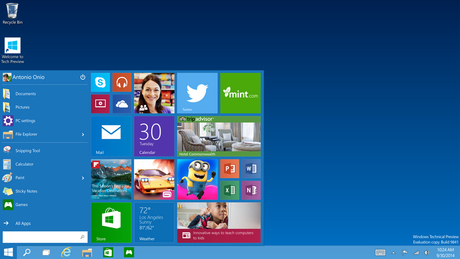Windows 10 designed for enterprise customers

Microsoft is skipping Windows 9 and going straight to Windows 10. The software giant is today launching a technical preview of the upcoming operating system in advance of its debut next year.
The company said the new OS is designed to work across the broadest range of devices to date, from IoT devices to enterprise data centres.
Microsoft’s decision to design Windows 8 to deliver a consistent experience across smartphones, tablets and PCs has been blamed for its negative reception among some desktop users.
It has also been slow to take up, with only 13% of desktop PCs running Windows 8 or Windows 8.1 compared to 51% still running Windows 7, according to NetApplications. But there is evidence that the company is not falling into the same trap with Windows 10.
Windows 10 will include numerous tweaks to the user interface to address the common complaints that Windows 8 was less convenient to use on desktops rather than touchscreen devices.
The new desktop UI has a start button, unlike Windows 8 (one was added in Windows 8.1), but also integrates Metro tiles to the right of the start menu. Metro apps have also been redesigned to run in real windows instead of in full-screen or in tiles. Windows 10 also adds a floating taskbar, the ability to make use of multiple desktops and improvements to the Snap app moving feature that allow up to four apps to be quickly arranged into quadrants on the same screen.
Microsoft is touting the OS as being able to adapt to the devices consumers are using and provide an experience suitable for the form factor. “We’re not talking about one UI to rule them all - we’re talking about one product family, with a tailored experience for each device,” Microsoft EVP of Operating Systems Terry Myerson said in a blog post announcing Windows 10.
Microsoft has shown an example in action with a Surface laptop/tablet hybrid using the desktop UI until it detects that the keyboard has been detached, and then switching to the touchscreen version.
This also means developers will be able to write a single app that targets the entire ecosystem of Windows 10 devices, Myerson said. Microsoft will make applications available through a single app store compatible with all the devices. Enterprise customers will be able to create a customised, curating app store for their employees.
The new OS will also have numerous enhancements tailored to business customers. Microsoft General Manager for Security Jim Alkove said Windows 10 has been designed with enterprise customers in mind.
Security enhancements include enterprise-grade security and identity features and data protection at the file level. Windows 10 will also come with in-built mobile device management (MDM) tools, expanding the capabilities beyond smartphones and into laptops and desktops.
Microsoft has also “simplified management and deployment to help lower costs, including in-place upgrades from Windows 7 or 8 that are focused on making device wipe-and-reload scenarios obsolete,” Alkove said.
Windows updates will be changed so that businesses can opt to receive the latest updates as soon as possible, or “lock-down mission-critical environments to receive only security and critical updates to their systems”.
Microsoft expects to launch Windows 10 sometime after the company’s next Build developer conference, which is in April 2015. Pricing and technical requirements have not yet been announced.
Is the Australian tech skills gap a myth?
As Australia navigates this shift towards a skills-based economy, addressing the learning gap...
How 'pre-mortem' analysis can support successful IT deployments
As IT projects become more complex, the adoption of pre-mortem analysis should be a standard...
The key to navigating the data privacy dilemma
Feeding personal and sensitive consumer data into AI models presents a privacy challenge.




